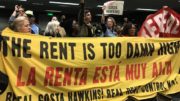By Nick Brunner
Nur Kausar works for EAH Housing as a business development manager. EAH is a nonprofit, affordable housing developer and manager with more than 20,000 affordable homes in California. The developer is now starting construction on its first project in Sacramento on 19th and Broadway, with 104 family apartments to open in 2025.
Jonathan Cook is the executive director of Sacramento Housing Alliance, an advocacy organization that focuses on affordable housing and homelessness. The two Sacramento residents recently met up to talk about the importance of city-county partnerships, prohousing leadership and the ‘long-term’ investment in affordable housing.
The conversation was recorded for the podcast Housing in the Capital.
Kausar: There’s a couple of things I really love about Sacramento … [and] why my husband and I chose to settle here. We had a lot of options, we used to live in San Francisco actually, and I’m from Las Vegas. He’s from the East Coast. So when we were finally deciding where to go, we wanted a place that was very diverse, walkable, had public transit, had access to good education, because we knew we were going to have kids. Honestly, diversity was probably top of mind for me.
I hadn’t lived in Sacramento before, and so when we did finally end up here, I did find it interesting how there were still pretty significant pockets of segregation, which, as I went further into my affordable housing career over the last decade, have found that is actually the case in a lot of the country. In a lot of places in California — and there’s a lot of really great research and information out there about why and kind of how to reverse that — but, ultimately, it does have to do again with housing and who we allowed to live in certain neighborhoods and who we didn’t and who was allowed to get a mortgage and who wasn’t. The way that the city of Sacramento has been set up over time, because of exclusionary zoning, and because of racist housing policies, I feel like we have a responsibility as advocates. And I think the city elected officials have a responsibility to do everything possible to reverse that. I’m not going anywhere, I want to live here, and I want my kid to grow up here, and I want it to be inclusive, and I want him to feel included, and I want all of his friends of all different colors to feel included and not feel like they have to live in certain neighborhoods, because they don’t make enough money, or they make more money than somebody else, or they have a certain skin color.
I do wonder [about] the impact that has on children over time, and what they see and how they are raised and how they grew up when there is that level of segregation. … I feel like Sacramento is a really good case study for how do we reverse these things so that we have this really great future for our kids? I’m kind of excited about that. That’s also why I really want to build more affordable homes in Sacramento. It’ll definitely help with the anti-displacement work that we’re doing with the Sacramento Housing Alliance. I think getting those community benefits agreements in place, will be really helpful for just our economy, our future workforce and who gets to actually get these great jobs and make enough money to be able to afford a home here. Ultimately, to me, [it] goes back to housing and where you are able to live and how you were able to grow up that matters.
Cook: My husband and I moved out here a little over two years ago from the Bay Area. We really liked Sacramento. … And we live in a really diverse neighborhood. We live in a condo and a six-plex. We love it. And I think Sacramento’s housing is unique. In Midtown, If you think of all the high rises, you have really dense apartment and condo buildings, Victorians and then older homes that have been converted into multiple units. So I think it really has a diversity of the type of housing that we have, and that we can continue to build.
Unique from the Bay Area is that a lot of Sacramento isn’t completely built out. So we have newer communities up in north Natomas. We also have a lot of infill opportunities here in Midtown, some of the conversion of former state buildings into housing as a unique opportunity. And I think the diversity that we have here as an opportunity to really have a community that looks and feels like what we all want, where it’s kids playing together, safe streets, where we can walk to our favorite restaurants, or to our local corner store. I’m hopeful that we can have transit that’ll take us all the way up to the airport someday. So I think it’ll be one of those things where it’s interconnected.
So you have housing, focusing on transit and climate, safe streets for all of us to walk on and safe neighborhoods and first, to have a safe neighborhood, you have to have a safe home. And from my social service background, it’s really thinking about this holistically, where if you think about your psychology 101 course, Maslow’s Hierarchy of Needs: Housing is the foundation of all of that. If you don’t have a safe place to live, you can’t address anything else in your life. And I think that, as a community, we really need to be invested in making sure that that’s a reality for everyone, because it improves all of our lives. When we have folks living in unsafe homes, they can have better health outcomes. They can live in safe communities, and it’s better for our economy. There’s going to be an investment of millions of dollars here for wonderful housing, as well as business opportunities, folks who are able to get back into the workforce. And so I think it’s just a net gain for all of us here in the city of Sacramento, but in the greater Sacramento region as well.
Kausar: As far as [the question of] is NIMBYism justified, I don’t know that there’s any situation where we should be, like, we don’t want to house people. … I don’t fundamentally understand as a human being why you would want to see someone suffer.
Cook: They don’t want the encampments … Then the next step is to get those people into housing. And then when that housing development has been proposed for supportive housing for formerly homeless folks, they object to that. It’s just like what are you actually wanting to accomplish on those? Because is it just you don’t want this next to your business? You don’t want those next to your house? Or do you actually fully understand what the next steps are to get folks off the street who are experiencing homelessness?
Kausar: So you think it’s more just an educational thing? Like, we just have to be able to keep talking about it and providing people with information and doing the community engagement. Honestly, I’ve only been doing this for 11 years now, but in those 11 years, I do feel like I am still facing the same issues I was 11 years ago, as far as the opposition. A lot has also changed. We are as an industry and as an advocacy community, talking about how to change the narrative. Putting out actual studies and information and toolkits to help folks figure out, OK, here’s how you talk about this in a way that will make sense to your neighbor so that they know exactly what you’re talking about. It’s not coming from a place of fear or a lack of understanding. And I think that’s super helpful. But do you think that’s it?
Cook: We are still having a lot of the same conversations we’ve been having for over 10 years. That’s true. … Then this last [legislative] session, there was a really robust housing package that the governor signed. That is really helping, because you have people who represent really NIMBY communities … that are looking at these solutions at a state level and trying to come up with solutions. I think that’s part of it.
But then it’s also, I think, more of a challenge for local elected officials at the city and county level. Because it’s someone who says: This is my neighborhood, specifically here, you live next to me, or these turf wars that are happening between the county and the city where they’re like, hey, city, you’re not doing enough to address the encampments in front of our workplace, or in front of our business. And this is negatively impacting my employees, clients, customers, whatever it may be. And I think that’s also a legitimate concern. So I think you have to balance: How do we manage these concerns of folks who are wanting to see this problem solved?
Because if we have encampments along a river parkway or in front of businesses, I don’t think any of us think that’s a great thing. But also explaining that, OK, we could clean up an encampment, but where are they going to go if we don’t have those units?
Kausar: Exactly.

Cook: Or if we get folks off the street, they have a place to go. So explaining what the next step is and how that works in terms of how we develop our community, and how we shift that narrative, I think that’s incumbent on all of us — the advocates, the local elected officials, business owners, of bringing together those diverse coalitions to have this collective framework of this is how we explained it to folks and then understanding that for the elected officials, there’s probably going to be some opposition, you’re gonna piss some people off, inevitably. And you have to be OK with that. I think if you’re a politician, you have to develop a pretty tough skin. That’s why I’m not a politician. I’m an advocate, because I get to say things as I see them. It takes a little bit of political courage to be able to make some of these decisions.
Kausar: I think you’re right. … I think it’s a replicable model. There are places, for example, during the pandemic that received some state funding, or the federal money that came down for COVID-19, that was used at the state level for housing, mostly to make sure that the unhoused population could be brought in safely, so that we weren’t going to have a mass outbreak. So things like Roomkey and Homekey in the places that were able to tap into those resources quickly and get folks inside. …
Cook: [Recently], the housing authority SHRA [Sacramento Housing and Redevelopment Agency] for the county and city of Sacramento, released their plan for the next few years. They have proposed to develop 2,000 units of permanent supportive housing for folks experiencing homelessness. That’s good. But it’s also not meeting the urgency of the situation we’re finding ourselves in when you have over 10,000 unhoused folks in Sacramento County. So I think it needs to be more ambitious and aggressive in terms of the investment that we’re making and working with all of our partners to scale up these investments. Because it is a significant investment if we need to invest $10 billion annually in California to just build the amount of affordable housing we need. And then the private sector, they need to build housing of every level — that macroeconomic situation, because that lowers the affordability problem, when you have a greater supply, and take some of that pressure off. So I think it’s just coming at this from a multiple-pronged approach, because it’s going to require solutions from the business community from local government, nonprofits, advocates, and that collective impact that we can find ourselves having when we come together.
Kausar: I was at a Solving Sacramento event, actually … it was about the new housing laws, and what else do we still need to do? The speaker mentioned the potential $10 billion bond that will be on the ballot in 2024 for affordable housing and homelessness funding. And somebody in the audience was like, well, where’s that money coming from? How do we scale up? … I feel like that’s always a good question, especially for the public. Because, I think it is hard to wrap our heads around such large numbers. But, thinking about, well, if the state’s budget is $300 billion a year, and we spent probably around $18 billion to 20 billion a year on education, we spend probably about that much on prison systems and on health care, right? … Thinking about how we’re spending and all these other places, how are we matching the need? And how are we matching what we’re seeing on the streets for investment in affordable housing?
Places like LA and the Bay Area have been looking at the cost savings when you house someone. … For example, if we decrease our unhoused population in Sacramento, that’s probably going to have a positive impact on our health care system. In our emergency system, you’re gonna have fewer ER visits, you’re gonna have fewer police calls, you’re gonna have fewer issues outside on the streets, right, you’re gonna also probably not have to create so many temporary, very expensive shelters, because you’ll need fewer of them once folks are permanently housed. Those shelters are expensive to run and manage, and they need water and food and air conditioning and 24-hour security. So if you’re gonna invest in affordable housing it’s a long-term investment.
Cook: I agree. … In Sacramento, I think both for the county and in the city, we need an inclusionary zoning ordinance so that we can require all developments to have a certain percentage allocated for affordable housing, because that’s part of the solution as well. And then making sure that folks aren’t getting left behind when we’re doing development So we’re also wanting to have the city adopt a community benefits agreement ordinance. This has been a successful model in other cities across the country. We’re looking at that particularly for the coalition — we’re part of the Sacramento Investment Without Displacement around the Aggie square development at the UC Davis Med Center campus, [in the] historically Black neighborhood of Oak Park, and making sure that part of that development and investment — we want investments in our community. But we also want to make sure that part of that money gets invested back into the people who live in those communities and that their kids can go to college and live in safe communities and have walkable communities. And there’s a tangible benefit from those investments for all of us.
Cook: To the credit of our leadership here in Sacramento, that we have a prohousing City Council. I think it’s encouraging at the last city council meeting that I attended, that each of the council members were supportive of increasing density and opportunities for zoning changes, and each of their council districts to have an increase in that density. … The challenges that we’re facing are significant. And so for both the city and the county to be able to really ameliorate the situation for our unhoused population, it’s really gonna take an aggressive investment, and a lot of coordination between multiple jurisdictions, all of the cities and Sacramento County, by county itself and the City of Sacramento to build these permanent supportive housing units to build temporary shelters to get folks off the street supportive housing, and the supportive staff that comes with that. … It’s just going to take a real historic investment to be able to meet the need that we find ourselves facing in 2023.
Kausar: We’re moving in the right direction in terms of at least that we have this prohousing council and mayor that know what the solutions are, and it’s just a matter of getting those across the finish line. I think once that happens, we will see a pretty massive shift in the city. And hopefully, the county will go in the same direction. But yeah, ultimately, it’ll just go down to, are we getting that local resource? And are we changing local ordinances to be more pro people, right, like, are we thinking about the folks that we need to keep housed and the folks that are on the streets? And what are we doing to help them?
Cook: From my perspective, [the biggest roadblock to progress] is really a funding problem. I think in the Sacramento region, we need a permanent funding source for affordable housing, and for permanent supportive housing. That’s the biggest thing in my view. And then also making sure we have greater coordination between jurisdictions. So making sure that we’re working in partnership with the county with the state and the federal government to make sure that we’re maximizing all of the dollars that should be coming to our region to build those.

Kausar: I will say [on the] working level, those are the two things that are my daily barriers. If I find a site I’m very excited about it, because I’ve been able to maybe check off certain boxes. Is it close to transit? Is it close to schools? Is it close to other amenities that people need? Yes, yes, yes. Now I need some local money because I have to apply to the state for very competitive funds. And I’ll be more competitive if I have local dollars to match. Do I have those? No. So that’s already one barrier. And then yeah, the second barrier is that partnership. Like, I need to make sure that I’m coordinating with a Continuum of Care, with the Sacramento Housing Redevelopment Agency, with the city with the county, anyone that’s involved in providing supportive or affordable homes to folks that are in need. … That becomes another barrier that I think is definitely solvable, as long as we’re working together. But we all have to be able to take that step. …
Kausar: I moved here from Southern Utah. My rent went from $400 a month to close to $800 a month. So it doubled. I actually looked up affordable housing sites. This was before I worked in affordable housing. … The Capitol Area Development Authority actually came up and they did have units available, and they were income restricted. So that is where I moved to, because I applied and got in and it was great. I wish that everybody could do that. Because yeah, when you look at the CADA site, there’s a massive waitlist for all of their units and every other affordable housing development.
When we open a new development, we’ll get thousands of applications for 100 units. And that’s the case for any developer that you’ll talk to in the entire state. … We know that for everyone that actually needs housing assistance — and for the United States, that’s usually a housing voucher — there’s only one available for every four families [that] actually need it. And it’s sometimes not enough because the market rent might be much higher than what that voucher will pay for. We know that the need is there, and folks are not finding those units, even though they need them.
Cook: Rents have gone up significantly over the last two years in particular. I have two large apartment complexes next to my community, and I was looking and a studio is almost $2,000 a month at the apartment building right next to me. So it’s kind of stunning to see the cost of everything that’s gone up and it’s really tough for folks to live on their own. If you’re going to be living with a roommate, that’s something I would recommend. But if you’re going to try to live on your own in a studio or for a one-bedroom apartment, that’s tough, because often you’re not going to find something you can afford easily.
Kausar: My husband and I lived in San Francisco, we had rent control. And I will say honestly, that was one of the reasons why we were able to save enough to then be able to buy our house here when we decided to move back. … But had my rent gone up 10 to 20% a year like, no, there’s no way I would have had enough extra cash to put aside [for a downpayment]. …
I’m always curious when folks are anti-rent control, because I’m like, well, I had my own personal experience, and I benefited from it, because I was able to then buy a house. And that’s even better, because now I know what my mortgage is every month. I’m not going to have this crazy increase of rent, because I own my home. But it just goes back to like, well, this is why owning property is such a big thing in the United States. That is the biggest wealth builder. It’s stability, it’s this asset, it’s a way to know how much money you can and can’t save, all the things that you need to do to like plan for your future are much easier when you have consistency in how much you’re spending every month.
Cook: With Prop 13, with property taxes, you’re basically setting your property tax rate, that’s not going to increase very much in the future. So, folks who are buying something now are at a disadvantage in terms of property tax compared to someone who bought that condo when it was built 15 years ago. So that’s just the structure that we have now.
I remember, when I was living in San Francisco, and [had] friends in Berkeley, rent control really makes a big difference. And that’s something I would like to see come here in Sacramento, because it really makes a difference. It keeps folks and these communities that make our city and our community. Interesting, in my opinion, right? You have artists, musicians, folks who are traveling workers, seasonal workers, we live in a really large agricultural valley, and that’s a wonderful thing — the Farm to Fork Capital.
I come from an [agricultural] area. I grew up in the North Bay and Napa County where we had a lot of seasonal workers and housing was incredibly expensive in Napa County. So you’d have situations where folks were living in bunk beds, and they were paying $300-$400 a week, because they didn’t have a locked-in lease or something like that. So there are a lot of situations where folks are having to live in really creative situations to be able to afford to have housing. And that housing insecurity where someone might be couchsurfing, or I had a friend who moved up to Sacramento to work here and she couldn’t secure a lease quickly. So she was living in [an] Airbnb for a month or two. Some of those situations aren’t great. I remember her telling me that the host wouldn’t allow her to use the kitchen, which seems crazy if you’re running a place and you can’t access a refrigerator or anything more than a microwave. So it’s really creating situations where folks aren’t able to live in a way that we’d want them to. So I think rent control definitely could be part of the solution here.
Kausar: I feel like I’m very lucky and benefit more than I should be compared to folks that don’t own homes. I remember this coming up with a former supervisor of mine, he mentioned that the mortgage interest deduction, at the federal level, costs us [about] $80 billion a year. And that’s just a little bit of money that every homeowner got when they bought their house … and that $80 billion could have easily just been reprioritized for homelessness or affordable housing. But we also get our mortgage interest deduction.
Cook: Also, as a homeowner that’s a nice thing for our taxes. But I wish that also applied to renters — renters don’t get that kind of relief. …
Ultimately, it benefits people who own commercial buildings, who own rental buildings … ultimately, I think it’s unsustainable because as a few create the situation where the rents go up so high, both for businesses and for individuals, you’re driving, a lot of folks out of these communities and, and situations with larger cities where you have a draw for a lot of jobs from the surrounding regions, your workforce is having to live further and further away. And so that reduces their quality of life if they’re having to commute three hours a day to get to and from work, [which] is not helping us get closer to our climate goals. … This is unsustainable, because you need to have a system where, sure, in this capitalist system, the rents can go up a certain percentage each year, that’s part of the inflationary environment we find ourselves in. Wages hopefully will go up at a rate that’s faster than that. But without having some sort of gauge or control to make sure that that’s happening in a sustainable way, that will be unsustainable.
Kausar: I wouldn’t want to hurt the folks that rely on rental income for their own income. When it becomes the situation where you have large commercial developers, or these large national landlords that are buying up properties, or having all these like luxury apartments go up and then not having any available at lower income levels, or having these really restrictive requirements to move in, or being basically exclusionary — that’s when public policy should step in and be like, OK, what’s really going on here? Is this best for the community?
I think that’s a totally different situation than like a mom and pop [shop]. So, yeah, I do think rent control would be really helpful just cause evictions and just access to help if you might think that you’re getting evicted. I think that’s a big thing too. I don’t think a lot of folks really know what to do, or how to get support or help or where to go and most of the time, the landlord will win. So, how do we make it a little bit more equitable, especially just knowing who’s getting evicted, and it’s going to tend to be lower income folks.
This conversation has been edited for length, flow and clarity.
This story is part of the Solving Sacramento journalism collaborative. Solving Sacramento is supported by funding from the James Irvine Foundation and Solutions Journalism Network. Our partners include California Groundbreakers, Capital Public Radio, Outword, Russian America Media, Sacramento Business Journal, Sacramento News & Review, Sacramento Observer and Univision 19.






Be the first to comment on "Housing in the Capital: Nur Kausar and Jonathan Cook on the importance of prohousing leadership and the ‘long-term’ investment in affordable housing "